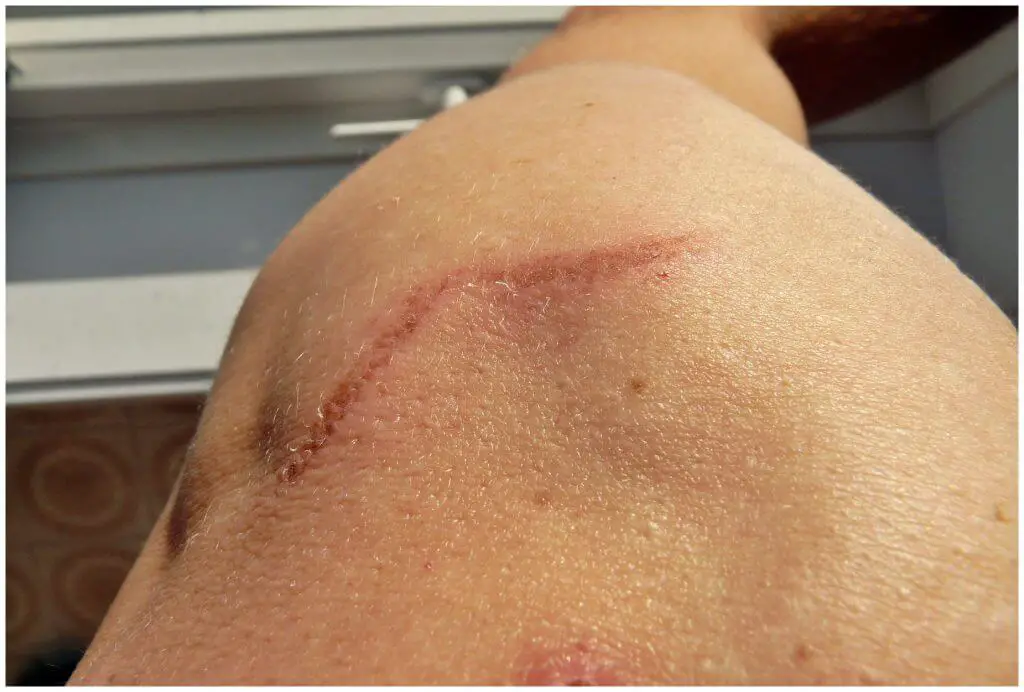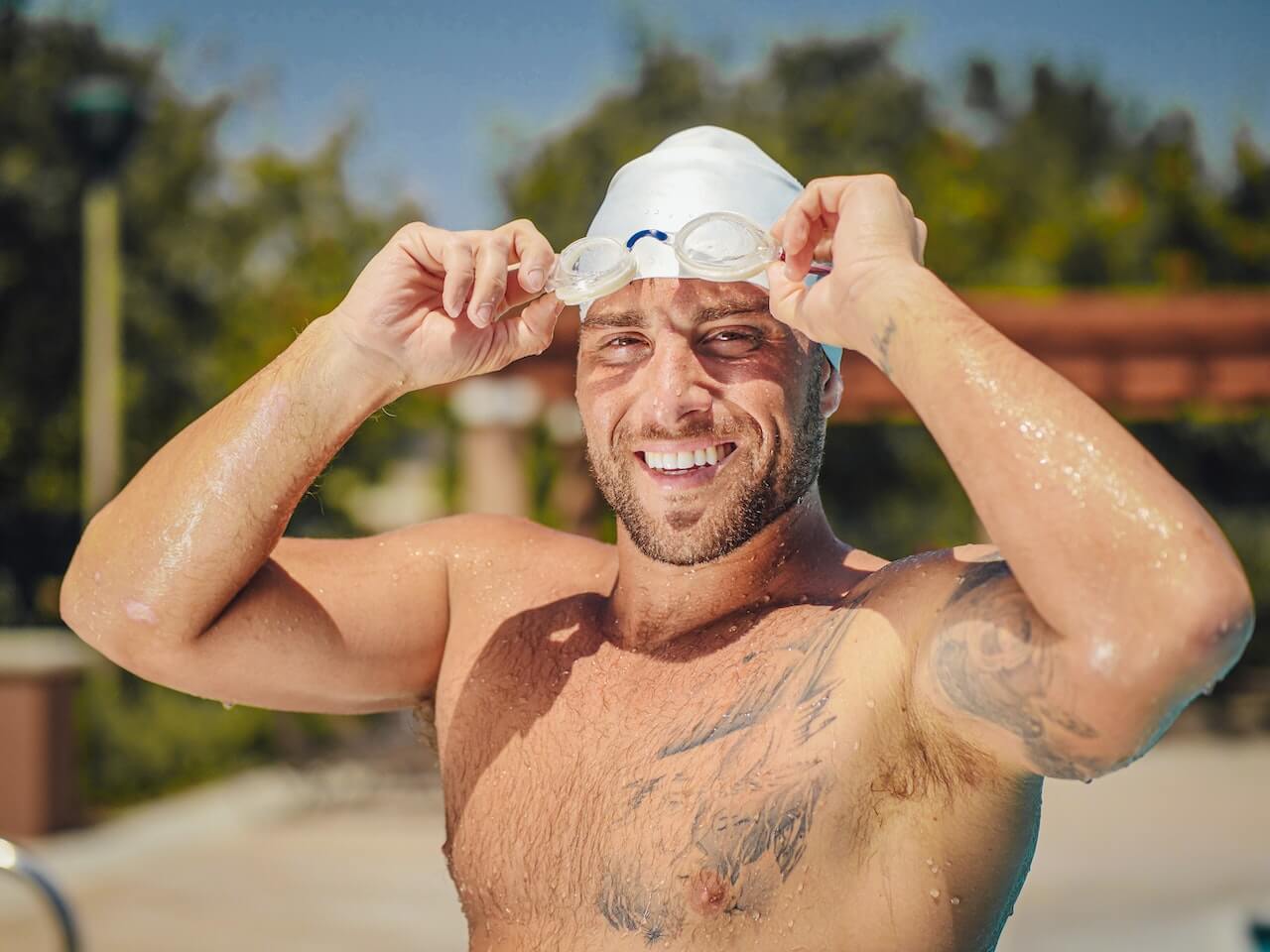After getting a tattoo removed, one common question that arises is how long do you have to wait before you can go swimming?

Generally, you should wait about 3-5 days after the removal for your tattoo to heal. However, healing may vary depending on factors such as the size, treated area, and how diligent you are following the aftercare instructions. If your tattoo is still red, itchy, or has blistering after 3-5 days, it’s best to avoid swimming until it’s fully healed.
In this article, we’ll talk a little bit about the tattoo removal process, why they all require you to wait a few days before you can go swimming, and how to take care of yourself post-tattoo removal.
Getting A Tattoo Removed
How Does Tattoo Removal Work?
One of the most common methods for tattoo removal is laser tattoo removal. As the name suggests, it involves using a laser to break down the ink particles in your tattoo, allowing your immune system to remove them from your body safely.
How it works is that different wavelengths of light target specific colors in the tattoo ink. The laser light gets absorbed by the ink particles, causing them to break apart. Your body’s immune system then works to remove the fragmented ink particles through natural processes.
Is Getting a Tattoo Removed Painful and Damaging to the Skin?
Yes, the laser tattoo removal process does cause some degree of skin damage, but this is typically a controlled and temporary damage meant to break down the tattoo ink for your body to naturally eliminate.
The process can be uncomfortable and is often compared to the sensation of a rubber band snapping against the skin.
The level of discomfort can vary based on the location, size, and color of the tattoo, as well as an individual’s personal pain tolerance. Topical or injectable anesthetics are often used to manage discomfort during the procedure.
What About Other Tattoo Removal Methods?
There are alternative methods of tattoo removal besides using a laser, although none are completely without risk or potential for skin damage either. Here are a few:
- Dermabrasion: This involves ‘sanding’ the skin to remove the surface and middle layers. It’s an invasive procedure that often results in significant skin damage and requires a lengthy healing time.
- Surgical Excision: In this procedure, the tattoo is removed surgically, and the skin is stitched back together. While it might be an option for small tattoos, it often leaves a scar and isn’t suitable for large tattoos.
- Chemical Peels: A chemical solution is applied to the skin, causing it to blister and peel off. The tattooed skin is then replaced over time by new, smoother skin. This method also involves significant healing time and may not completely remove all tattoo pigment.
- Tattoo Removal Creams: These are widely available but have mixed reviews regarding their effectiveness. They can also cause skin irritation and other adverse effects.
- Cover-up Tattoos: While not a method of removal, some people opt to work with a skilled tattoo artist to design a new tattoo that effectively covers the old one.
- Microneedling: This process involves puncturing the skin with tiny, sterile needles to promote skin regeneration. While it’s not traditionally used for tattoo removal, some practitioners are exploring its potential in combination with other methods.
No matter what method you’re considering, you should understand that all involve some level of skin trauma and healing time, which is why you cannot go swimming right away. Just like with getting a new tattoo, getting a tattoo removed is a process that requires time and patience.
The Healing Process Post Tattoo Removal

After your tattoo removal session, you need to care for the treated area to promote proper healing. You may experience redness, swelling, and some discomfort in the area where the laser was used.
Here are some aftercare tips to ensure a smooth healing process:
- Keep the treated area clean and dry, avoiding direct water exposure for the first few days.
- Apply a thin layer of antibiotic ointment to the area as directed by your removal specialist.
- Keep the area covered with a sterile bandage for the first 24 hours.
- Avoid swimming or soaking in water for at least 3-5 days after your tattoo removal session. If the tattoo is still red, itchy, or has blistering after this time, it’s best to avoid swimming until the area has healed completely.
- Protect the treated area from direct sunlight by covering it with clothing or applying sunscreen with an SPF of 30 or higher once the area has healed.
Monitor the post-tattoo healing process and consult your removal specialist if you experience any complications or have concerns about your progress.
Follow their specific aftercare instructions to a T, as this can greatly impact the success of your tattoo removal and help you get back to enjoying activities like swimming as soon as possible.
How Swimming Affects Healing After Tattoo Removal
Risks of Swimming Too Soon After Tattoo Removal

Swimming too soon after your tattoo removal can pose several risks for your healing process.
Submerging the treated area in water, especially pools, hot tubs, or natural bodies of water such as oceans, lakes, or rivers, increases the chance of exposing the open wound to bacteria and causing an infection. This is because these water sources contain various types of bacteria, unlike clean water in your home.
For this reason alone, you should wait until your tattoo has fully healed before going for a swim, as this helps prevent complications.
If your treated area is still red, itchy, or has blisters after 3-5 days, it’s best to avoid swimming until it has healed completely.
While a waterproof dressing may protect your treated area so that you can shower, it’s still advisable to be cautious and avoid total submersion such as entering a pool, hot tub, swim spa, or any large water body.
How Water Quality Impacts Healing
Water quality plays a significant role in your tattoo removal healing process. Chlorine present in swimming pools and salt water in oceans can leach ink from a newly treated tattoo, causing fading and discoloration.
Moreover, even chlorinated water is not bacteria-free, and exposure to pool water can increase the risk of infection and lead to further complications such as bubbling and scarring.
To ensure your tattoo heals properly, avoid exposing it to bodies of water with a low water quality, which basically means anything that’s not your shower stall.
Instead, focus on keeping the treated area properly cared for and clean with fresh water during the healing process. This way, you’ll be protecting your tattoo and ensuring it remains as sharp and vibrant as possible for the beach season!
Guidelines for Swimming Post Tattoo Removal

When Can You Start Swimming
Typically, the healing period for a tattoo removal ranges from 3-5 days, but it may vary depending on your skin type and the removal technique used.
Keep in mind that if your treated area is still red, itchy, or blistered after 3-5 days, it’s best to avoid swimming until fully healed.
Signs Your Skin is Ready for Swimming
To determine if your skin is ready for swimming, pay close attention to the following signs:
- No redness or irritation: Your treated area should no longer appear red or swollen.
- No blistering or oozing: Blisters and oozing can indicate that your skin hasn’t fully healed and could be susceptible to infection.
- Fully closed skin: Ensure that there are no open wounds or scabs that could allow bacteria to enter.
Remember, everyone’s healing process is different, so consult your tattoo removal specialist or healthcare provider if you’re unsure whether your skin is ready for swimming.
Protective Measures When Returning to Swimming
Once your skin has healed, and you’re ready to enjoy summer activities again, take some precautions to protect the treated area:
- Wear a cover sleeve or sun-protective clothing: This helps shield the treated area from direct sunlight, lowering the risk of scarring and tattoo degradation.
- Avoid prolonged exposure to water: Limit your swimming sessions, especially in bodies of water known to harbor harmful bacteria.
- Moisturize: Keep the treated area hydrated to promote healing and reduce irritation.
Following these guidelines can help minimize the risk of infection, irritation, and scarring while ensuring your removal progress remains on track.
Care Tips for Faster Recovery Post Tattoo Removal
Importance of Hydration and Diet
In addition to moisturizing your skin, proper hydration plays a significant role in your skin’s healing process after tattoo removal.
Staying hydrated helps keep your skin elastic and healthy, which can aid in recovery. Also, eating foods that promote skin health, such as those containing vitamin E and vitamin C, may also contribute to faster healing.
Effective Aftercare Routine
An effective aftercare routine is essential for your skin to heal properly and to prevent infection after the tattoo removal process.
- Cleanse properly: Gently cleanse the treated area twice a day using a mild, fragrance-free soap and lukewarm water. Pat it dry with a clean towel or a paper towel rather than rubbing or scrubbing the area.
- Moisturize and protect: Apply a thin layer of moisturizing ointments, such as Aquaphor, to keep the treated area moist. This helps avoid scabbing and promotes healing. Make sure to use a clean cotton swab or your clean fingers for application.
- Sun protection: Cover the treated area when going outside and apply a sunblock with at least SPF 25 when the skin is no longer open or weeping. Protecting your skin from the sun helps prevent further damage during the healing process.
- Avoid water activities: Allow your skin time to heal before engaging in water activities such as swimming. Wait for 3-5 days after the tattoo removal procedure before submerging in water.
By following these care tips, you can support quicker healing and reduce the risk of complications or infections. Remember, everyone’s body is different, and healing times can vary – so always listen to your body and consult with your tattoo removal specialist if you are unsure or concerned about any part of the aftercare process.
Sources:
